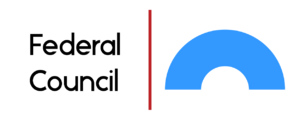Federal Council of Tarper: Difference between revisions
No edit summary |
mNo edit summary |
||
| Line 31: | Line 31: | ||
|party3 = CDSF | |party3 = CDSF | ||
|election3 = 28 September 2012 | |election3 = 28 September 2012 | ||
|seats = | |seats = 124 | ||
|structure1 = 2020 Tarperti Federal Council Diagram.svg | |structure1 = 2020 Tarperti Federal Council Diagram.svg | ||
|structure1_res = 300px | |structure1_res = 300px | ||
| Line 60: | Line 60: | ||
The '''Federal Council of Tarper''' is a legislative body that represents the twelve states of Tarper at the federal level. The Council meets at the Palace of States in Terraum. | The '''Federal Council of Tarper''' is a legislative body that represents the twelve states of Tarper at the federal level. The Council meets at the Palace of States in Terraum. | ||
The Federal Council participates in legislation, alongside the | The Federal Council participates in legislation, alongside the Federal Assembly, the directly elected representatives of the people of Tarper, with laws affecting state competencies and all constitutional changes requiring the consent of the body. It is the upper house of the Parliament of Tarper. | ||
The modern Federal Council is the successor similar upper houses in Tarper's history like the Imperial Diet of the | The modern Federal Council is the successor similar upper houses in Tarper's history like the Imperial Diet of the Platesan Empire, the General Courts of the Tarperti Kingdom, the Hall of Confederation of the Tarperti Confederation, and the Officer's Chamber of the Seconds Republic. | ||
The political makeup of the Council is affected by changes in power | The political makeup of the Council is affected by changes in power within the states of Tarper, and thus by elections in each state. Each state delegation in the Federal Council is essentially a representation of the state government and reflects the political makeup of the ruling majority or plurality of each state legislature (including coalitions). | ||
==History== | ==History== | ||
Revision as of 17:36, 20 July 2021
This article is incomplete because it is pending further input from participants, or it is a work-in-progress by one author. Please comment on this article's talk page to share your input, comments and questions. Note: To contribute to this article, you may need to seek help from the author(s) of this page. |
Federal Council of Tarper Conseil Fédéral de Tarper | |
|---|---|
| 6th Federal Council | |
 | |
| Type | |
| Type | of the Parliament of Tarper |
| History | |
| Founded | September 10, 2002 |
| Preceded by | Officer's Chamber (Second Republic of Tarper) |
| Leadership | |
Speaker of the Federal Council | Laraine Castilla, SP since 22 September 2016 |
Leader of the Federal Council | Abraham Reed, SP since 24 September 2012 |
Shadow Leader | Laurence Abram, CDSF since 28 September 2012 |
| Structure | |
| Seats | 124 |
 | |
Political groups | Government (68)
Opposition (56) |
| Elections | |
| Appointed by State legislature | |
Last election | 1 March 2020 |
Next election | 1 March 2024 |
| Meeting place | |
 | |
| Astran House of Nobles, Center, Terraum | |
The Federal Council of Tarper is a legislative body that represents the twelve states of Tarper at the federal level. The Council meets at the Palace of States in Terraum.
The Federal Council participates in legislation, alongside the Federal Assembly, the directly elected representatives of the people of Tarper, with laws affecting state competencies and all constitutional changes requiring the consent of the body. It is the upper house of the Parliament of Tarper.
The modern Federal Council is the successor similar upper houses in Tarper's history like the Imperial Diet of the Platesan Empire, the General Courts of the Tarperti Kingdom, the Hall of Confederation of the Tarperti Confederation, and the Officer's Chamber of the Seconds Republic.
The political makeup of the Council is affected by changes in power within the states of Tarper, and thus by elections in each state. Each state delegation in the Federal Council is essentially a representation of the state government and reflects the political makeup of the ruling majority or plurality of each state legislature (including coalitions).
